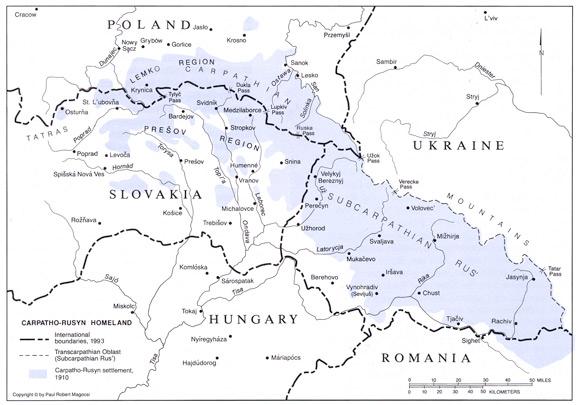Carpatho-Rusyns
Who are the Rusyns?
There is still much debate by scholars regarding the origins and early history of the Slavic people. What is agreed upon is that Slavic people have lived in the Carpathian region as early as the sixth century AD. The Carpatho-Rusyns are the direct descendants of one of these Slavic tribes that had lived along the Uz River called the White Croats (Bilyj Horvaty). By the 900s, waves of Slavic settlers calling themselves Rus' came from the East and began settling into the Carpathians, intermarrying and assimilating with the White Croats. From the Kievan Rus' kingdom they adopted their national name of "Rusiny," meaning -- the inhabitant or descendant of Rus'. In time it became the common name of all southeastern Slavic tribes from the Poprad River in Prijasevska Rus' all the way to the Caspian Sea and the River Don.
Since many Rusyns lived for centuries under Hungarian rule, they were often called Uhorsky Rusyny, Rusyns of Hungary. After World War I, they were called, from their habitat "Podkarpats'ky Rusyny," Rusyns living under the Carpathians. Those living in the Polish kingdom (later Austria) were called Rusnaky and later, Lemkos.
Geography
Three-quarters of the Carpatho-Rusyns in Europe are found within the borders of Ukraine, specifically in the Transcarpathian region (historic Subcarpathian Rus'). In Slovakia, Carpatho-Rusyns live in the northeastern part of the country, in an area popularly known as the Presov Region. On the northern slopes of the Carpathians, they had traditionally lived in southeastern Poland, in an area known as the Lemko Region. After World War II, the Lemko Rusyns were deported to Ukraine and other parts of Poland. Among those who remained in Poland, a few thousand eventually managed to return to their Carpathian homeland, although most continue to reside in scattered settlements in the southwestern part of the country (Silesia). Finally, there are several Carpatho-Rusyn villages just south of the Tisza River in the Maramures region of northcentral Romania, and a few scattered settlements in northeastern Hungary.

Beyond the Carpathian homeland, Rusyns live as immigrants in neighboring countries. The oldest immigrant community, dating back to the mid-eighteenth century, is in the Vojvodina (historic Backa) and Srem regions of former Yugoslavia, that is, present-day northern Serbia and far eastern Croatia. In the Czech Republic, Carpatho-Rusyns reside primarily in northern Moravia and the capital of Prague, where most immigrated just after World War II. The largest community outside the homeland is in the United States, where between the 1880s and 1914 about 225,000 Carpatho-Rusyns immigrated. They settled primarily in the industrial regions of the northeastern and north-central states where most of their descendants still live to this day.
Language
Carpatho-Rusyns belong to the Slavic branch of Indo-European peoples. Their dialects are classified as East Slavic and are closely related to Ukranian. Because they live in a borderland region, Carpatho-Rusyn dialects are heavily influenced by Polish, Slovak, and Hungarian vocabularies. In contrast to their West Slavic (Polish and Slovak), Magyar, and Romanian neighbors, Carpatho-Rusyns use the Cyrillic alphabet.
Religion
Christianity was first brought to the Carpathians during the second half of the ninth century. Two monks, Cyril and Methodius, from the Balkan peninsula of Europe, came to the area to Christianize the Slavs.
Cyril and Methodius as well as their disciples were from the Byzantine Empire. Therefore, when the Christian church was divided after 1054, the Carpatho-Rusyns remained within the Eastern Orthodox sphere nominally under the authority of the Ecumenical Patriarch of Constantinople. As Eastern Christians, the Carpatho-Rusyns used Church Slavonic instead of Latin as the language in religious services; followed the Liturgy of St. John Chrysostom; had married priests; and followed the old Julian calendar so that fixed feasts like Christmas eventually fell two weeks later than the western Gregorian calendar on January 7.
In the wake of the Protestant Reformation and the Catholic Counter Reformation, the government and local aristocracy began in the late sixteenth century to try to bring the Orthodox Carpatho-Rusyns closer to the official Roman Catholic state religion. The result was the creation of the Uniate Church in 1646, that is an Eastern Christian Church allied with Rome. The Uniates were allowed to retain their Eastern-rite traditions, but had to recognize the Pope in Rome as the head of their church. In 1772, the Uniates were renamed Greek Catholics. Eventually, in the United States they became known as Byzantine Catholics.